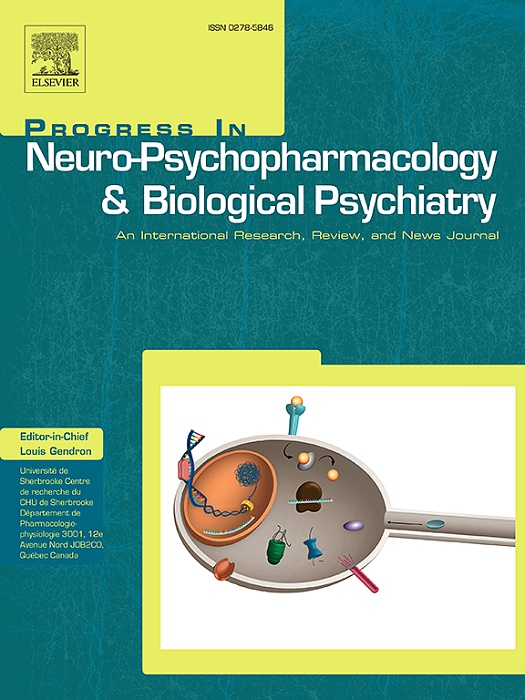Exploring the genetic landscape of the brain-heart axis: A comprehensive analysis of pleiotropic effects between heart disease and psychiatric disorders
IF 5.3
2区 医学
Q1 CLINICAL NEUROLOGY
Progress in Neuro-Psychopharmacology & Biological Psychiatry
Pub Date : 2024-10-17
DOI:10.1016/j.pnpbp.2024.111172
引用次数: 0
Abstract
Background
The genetic links between heart disease and psychiatric disorders are complex and not well understood. This study uses genome-wide association studies (GWAS) and advanced multilevel analyses to explore these connections.
Methods
We analyzed GWAS data from seven psychiatric disorders and five types of heart disease. Genetic correlations and overlaps were examined using linkage disequilibrium score regression (LDSC), high-definition likelihood (HDL), and Genetic analysis incorporating Pleiotropy and Annotation (GPA). Pleiotropic single-nucleotide variations (SNVs) were identified with pleiotropic analysis under the composite null hypothesis (PLACO) and annotated via Functional mapping and annotation of genetic associations (FUMA). Potential pleiotropic genes were identified using Multi-marker Analysis of GenoMic Annotation (MAGMA) and Summary data-based Mendelian Randomization (SMR).
Results
Among 35 trait pairs, 32 showed significant genetic correlations or overlaps. PLACO identified 15,077 SNVs, with 287 recognized as pleiotropic loci and 20 colocalization sites. MAGMA and SMR revealed 75 potential pleiotropic genes involved in diverse pathways, including cancer, neurodevelopment, and cellular organization. Mouse Genome Informatics (MGI) queries provided evidence linking multiple genes to heart or psychiatric disorders.
Conclusions
This analysis reveals loci and genes with pleiotropic effects between heart disease and psychiatric disorders, highlighting shared biological pathways. These findings illuminate the genetic mechanisms underlying the brain-heart axis and suggest shared biological foundations for these conditions, offering potential targets for future prevention and treatment strategies.
探索脑-心轴的遗传景观:全面分析心脏病和精神疾病之间的多效应。
背景:心脏病和精神疾病之间的遗传联系非常复杂,而且尚未得到很好的理解。本研究利用全基因组关联研究(GWAS)和先进的多层次分析来探讨这些联系:我们分析了七种精神疾病和五种心脏病的全基因组关联研究数据。方法:我们分析了七种精神疾病和五种心脏病的 GWAS 数据,并使用连锁不平衡评分回归(LDSC)、高分辨率似然法(HDL)和包含多向性和注释的遗传分析(GPA)研究了遗传相关性和重叠性。通过复合零假设下的多义性分析(PLACO)确定了多义性单核苷酸变异(SNV),并通过遗传关联的功能图谱和注释(FUMA)进行了注释。潜在的多向性基因是通过基因微注释多标记分析(MAGMA)和基于摘要数据的孟德尔随机化(SMR)确定的。采用孟德尔随机法评估因果关系:在 35 个性状对中,32 个性状显示出显著的遗传相关性或重叠性。PLACO 发现了 15,077 个 SNV,其中 287 个被认为是多效基因位点,20 个是共定位点。MAGMA 和 SMR 揭示了 75 个潜在的多效基因,这些基因涉及不同的途径,包括癌症、神经发育和细胞组织。小鼠基因组信息学(MGI)查询提供了多个基因与心脏或精神疾病相关的证据:这项分析揭示了心脏病和精神疾病之间具有多效应的基因位点和基因,突出了共同的生物通路。这些发现阐明了脑-心轴的遗传机制,并提出了这些疾病的共同生物学基础,为未来的预防和治疗策略提供了潜在的目标。
本文章由计算机程序翻译,如有差异,请以英文原文为准。
求助全文
约1分钟内获得全文
求助全文
来源期刊
CiteScore
12.00
自引率
1.80%
发文量
153
审稿时长
56 days
期刊介绍:
Progress in Neuro-Psychopharmacology & Biological Psychiatry is an international and multidisciplinary journal which aims to ensure the rapid publication of authoritative reviews and research papers dealing with experimental and clinical aspects of neuro-psychopharmacology and biological psychiatry. Issues of the journal are regularly devoted wholly in or in part to a topical subject.
Progress in Neuro-Psychopharmacology & Biological Psychiatry does not publish work on the actions of biological extracts unless the pharmacological active molecular substrate and/or specific receptor binding properties of the extract compounds are elucidated.

 求助内容:
求助内容: 应助结果提醒方式:
应助结果提醒方式:


